Analysis and Overview of a Residential Real Estate Sales Contract
VerifiedAdded on 2021/10/27
|9
|2116
|197
Report
AI Summary
This report analyzes a real estate contract for the sale of a residential house, detailing the agreement between the vendor and vendee, including the property description, financial terms, and conditions. The contract outlines the payment structure, including the down payment, balance, and interest rates. It specifies tenancy settlement, property conditions, and the inclusion of a Panasonic TV. The report also covers the duties and responsibilities of real estate agents, including contacting customers, negotiating prices, and maintaining client relationships. Furthermore, it examines disclosure requirements, agency commission structures, appraisal procedures, and exchange procedures. The report also discusses the rules regarding alterations and additions to residential premises, as per the Residential Tenancies Act 2010. Finally, it outlines the duties and responsibilities of property officers, including managing properties, marketing, tenant screening, and handling disputes, along with procedures for tenancy agreements, rent payments, and termination scenarios. The provided contract and information sheet provides a comprehensive overview of real estate transactions and property management practices.

REAL ESTATE 1
Real estate
Name
Institution affiliation
Date
Real estate
Name
Institution affiliation
Date
Paraphrase This Document
Need a fresh take? Get an instant paraphrase of this document with our AI Paraphraser
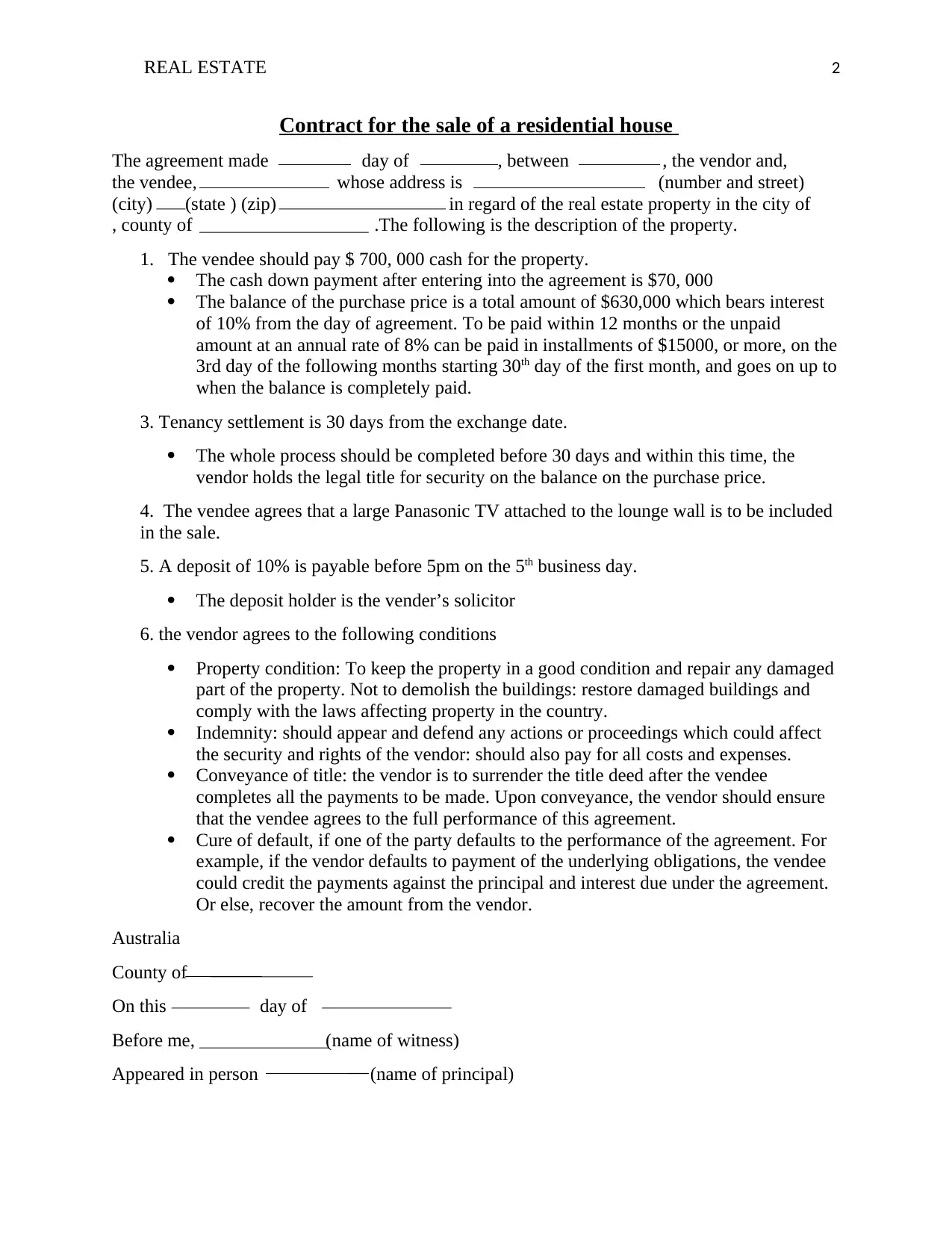
REAL ESTATE 2
Contract for the sale of a residential house
The agreement made day of , between , the vendor and,
the vendee, whose address is (number and street)
(city) (state ) (zip) in regard of the real estate property in the city of
, county of .The following is the description of the property.
1. The vendee should pay $ 700, 000 cash for the property.
The cash down payment after entering into the agreement is $70, 000
The balance of the purchase price is a total amount of $630,000 which bears interest
of 10% from the day of agreement. To be paid within 12 months or the unpaid
amount at an annual rate of 8% can be paid in installments of $15000, or more, on the
3rd day of the following months starting 30th day of the first month, and goes on up to
when the balance is completely paid.
3. Tenancy settlement is 30 days from the exchange date.
The whole process should be completed before 30 days and within this time, the
vendor holds the legal title for security on the balance on the purchase price.
4. The vendee agrees that a large Panasonic TV attached to the lounge wall is to be included
in the sale.
5. A deposit of 10% is payable before 5pm on the 5th business day.
The deposit holder is the vender’s solicitor
6. the vendor agrees to the following conditions
Property condition: To keep the property in a good condition and repair any damaged
part of the property. Not to demolish the buildings: restore damaged buildings and
comply with the laws affecting property in the country.
Indemnity: should appear and defend any actions or proceedings which could affect
the security and rights of the vendor: should also pay for all costs and expenses.
Conveyance of title: the vendor is to surrender the title deed after the vendee
completes all the payments to be made. Upon conveyance, the vendor should ensure
that the vendee agrees to the full performance of this agreement.
Cure of default, if one of the party defaults to the performance of the agreement. For
example, if the vendor defaults to payment of the underlying obligations, the vendee
could credit the payments against the principal and interest due under the agreement.
Or else, recover the amount from the vendor.
Australia
County of
On this day of
Before me, (name of witness)
Appeared in person (name of principal)
Contract for the sale of a residential house
The agreement made day of , between , the vendor and,
the vendee, whose address is (number and street)
(city) (state ) (zip) in regard of the real estate property in the city of
, county of .The following is the description of the property.
1. The vendee should pay $ 700, 000 cash for the property.
The cash down payment after entering into the agreement is $70, 000
The balance of the purchase price is a total amount of $630,000 which bears interest
of 10% from the day of agreement. To be paid within 12 months or the unpaid
amount at an annual rate of 8% can be paid in installments of $15000, or more, on the
3rd day of the following months starting 30th day of the first month, and goes on up to
when the balance is completely paid.
3. Tenancy settlement is 30 days from the exchange date.
The whole process should be completed before 30 days and within this time, the
vendor holds the legal title for security on the balance on the purchase price.
4. The vendee agrees that a large Panasonic TV attached to the lounge wall is to be included
in the sale.
5. A deposit of 10% is payable before 5pm on the 5th business day.
The deposit holder is the vender’s solicitor
6. the vendor agrees to the following conditions
Property condition: To keep the property in a good condition and repair any damaged
part of the property. Not to demolish the buildings: restore damaged buildings and
comply with the laws affecting property in the country.
Indemnity: should appear and defend any actions or proceedings which could affect
the security and rights of the vendor: should also pay for all costs and expenses.
Conveyance of title: the vendor is to surrender the title deed after the vendee
completes all the payments to be made. Upon conveyance, the vendor should ensure
that the vendee agrees to the full performance of this agreement.
Cure of default, if one of the party defaults to the performance of the agreement. For
example, if the vendor defaults to payment of the underlying obligations, the vendee
could credit the payments against the principal and interest due under the agreement.
Or else, recover the amount from the vendor.
Australia
County of
On this day of
Before me, (name of witness)
Appeared in person (name of principal)
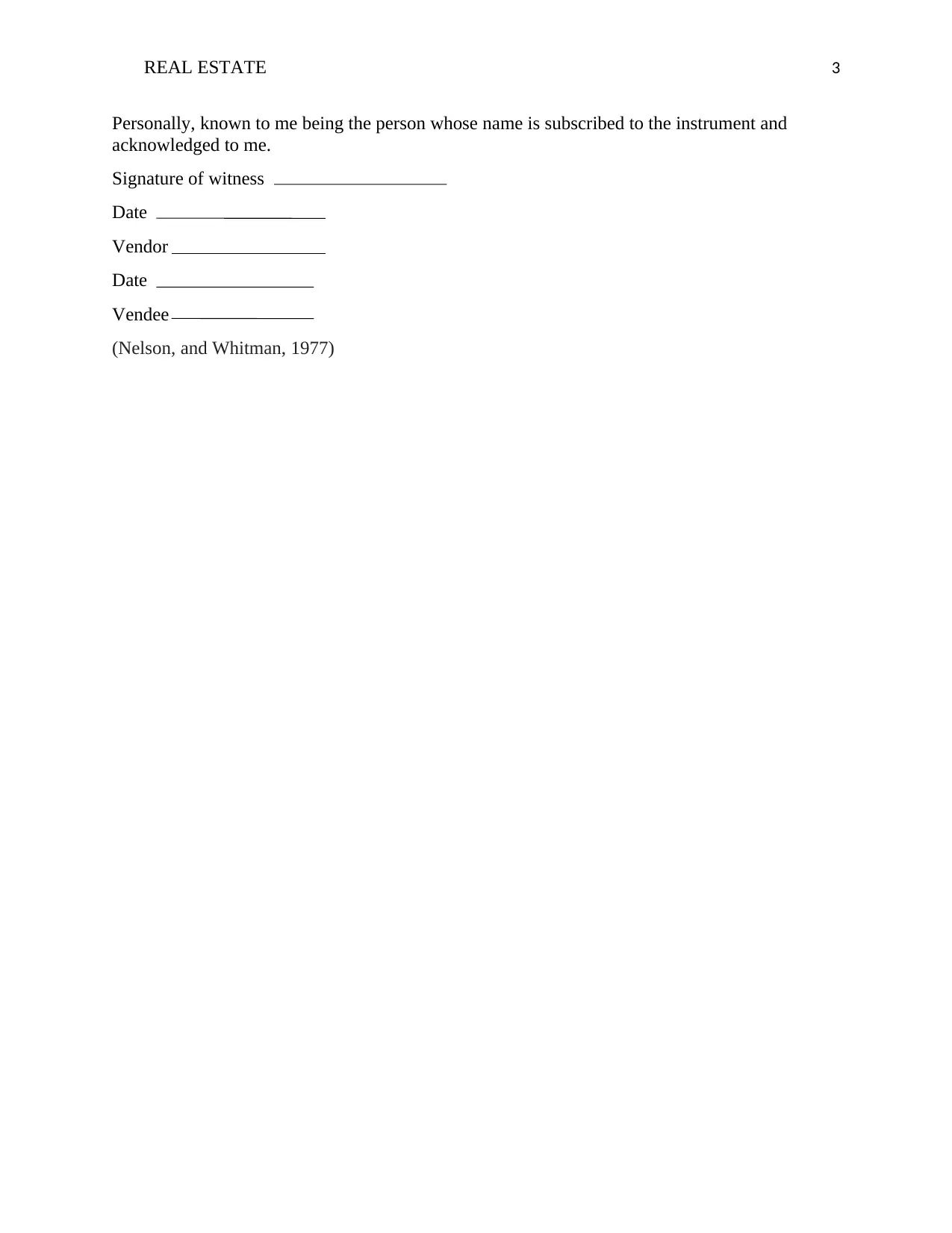
REAL ESTATE 3
Personally, known to me being the person whose name is subscribed to the instrument and
acknowledged to me.
Signature of witness
Date
Vendor
Date
Vendee
(Nelson, and Whitman, 1977)
Personally, known to me being the person whose name is subscribed to the instrument and
acknowledged to me.
Signature of witness
Date
Vendor
Date
Vendee
(Nelson, and Whitman, 1977)
⊘ This is a preview!⊘
Do you want full access?
Subscribe today to unlock all pages.

Trusted by 1+ million students worldwide
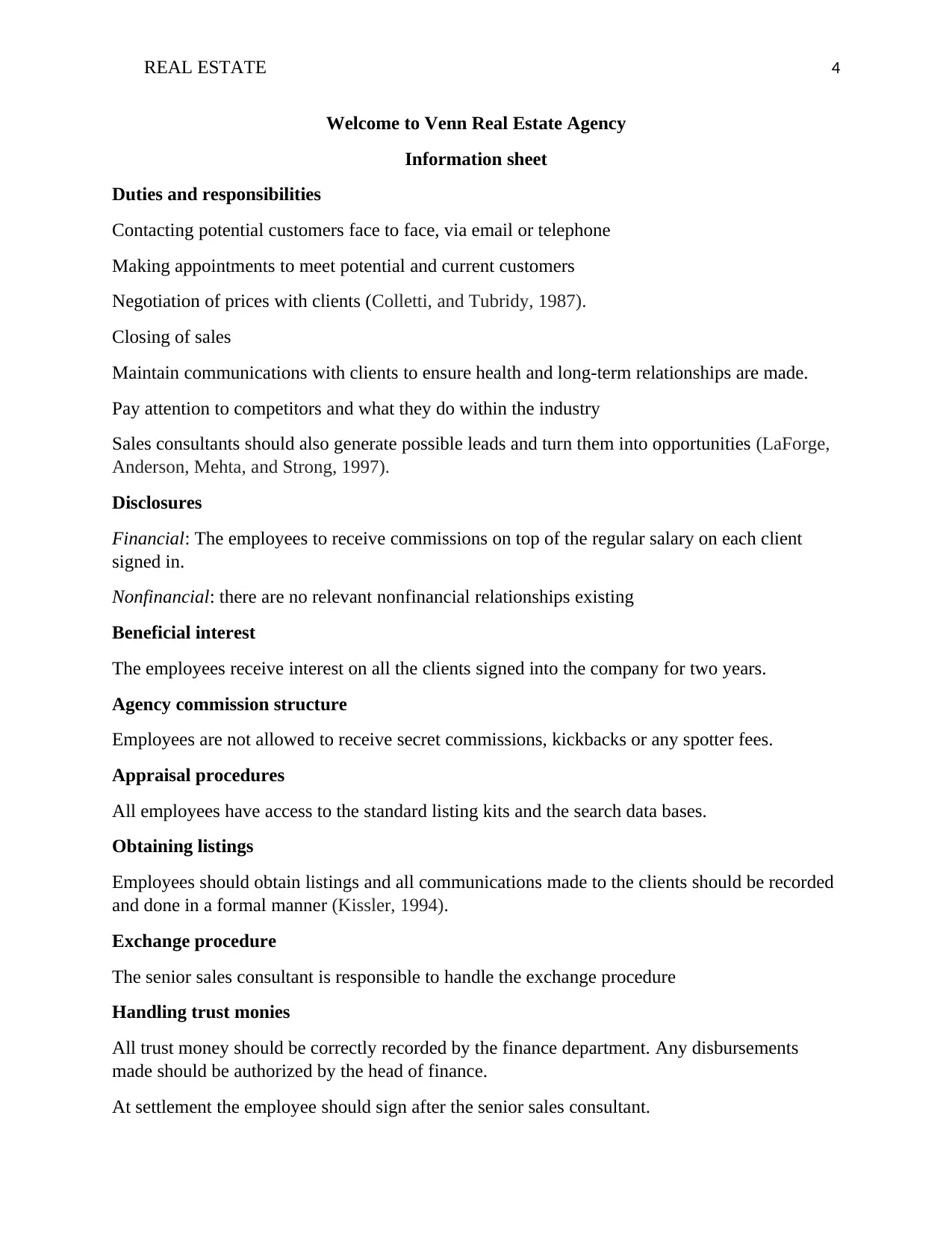
REAL ESTATE 4
Welcome to Venn Real Estate Agency
Information sheet
Duties and responsibilities
Contacting potential customers face to face, via email or telephone
Making appointments to meet potential and current customers
Negotiation of prices with clients (Colletti, and Tubridy, 1987).
Closing of sales
Maintain communications with clients to ensure health and long-term relationships are made.
Pay attention to competitors and what they do within the industry
Sales consultants should also generate possible leads and turn them into opportunities (LaForge,
Anderson, Mehta, and Strong, 1997).
Disclosures
Financial: The employees to receive commissions on top of the regular salary on each client
signed in.
Nonfinancial: there are no relevant nonfinancial relationships existing
Beneficial interest
The employees receive interest on all the clients signed into the company for two years.
Agency commission structure
Employees are not allowed to receive secret commissions, kickbacks or any spotter fees.
Appraisal procedures
All employees have access to the standard listing kits and the search data bases.
Obtaining listings
Employees should obtain listings and all communications made to the clients should be recorded
and done in a formal manner (Kissler, 1994).
Exchange procedure
The senior sales consultant is responsible to handle the exchange procedure
Handling trust monies
All trust money should be correctly recorded by the finance department. Any disbursements
made should be authorized by the head of finance.
At settlement the employee should sign after the senior sales consultant.
Welcome to Venn Real Estate Agency
Information sheet
Duties and responsibilities
Contacting potential customers face to face, via email or telephone
Making appointments to meet potential and current customers
Negotiation of prices with clients (Colletti, and Tubridy, 1987).
Closing of sales
Maintain communications with clients to ensure health and long-term relationships are made.
Pay attention to competitors and what they do within the industry
Sales consultants should also generate possible leads and turn them into opportunities (LaForge,
Anderson, Mehta, and Strong, 1997).
Disclosures
Financial: The employees to receive commissions on top of the regular salary on each client
signed in.
Nonfinancial: there are no relevant nonfinancial relationships existing
Beneficial interest
The employees receive interest on all the clients signed into the company for two years.
Agency commission structure
Employees are not allowed to receive secret commissions, kickbacks or any spotter fees.
Appraisal procedures
All employees have access to the standard listing kits and the search data bases.
Obtaining listings
Employees should obtain listings and all communications made to the clients should be recorded
and done in a formal manner (Kissler, 1994).
Exchange procedure
The senior sales consultant is responsible to handle the exchange procedure
Handling trust monies
All trust money should be correctly recorded by the finance department. Any disbursements
made should be authorized by the head of finance.
At settlement the employee should sign after the senior sales consultant.
Paraphrase This Document
Need a fresh take? Get an instant paraphrase of this document with our AI Paraphraser
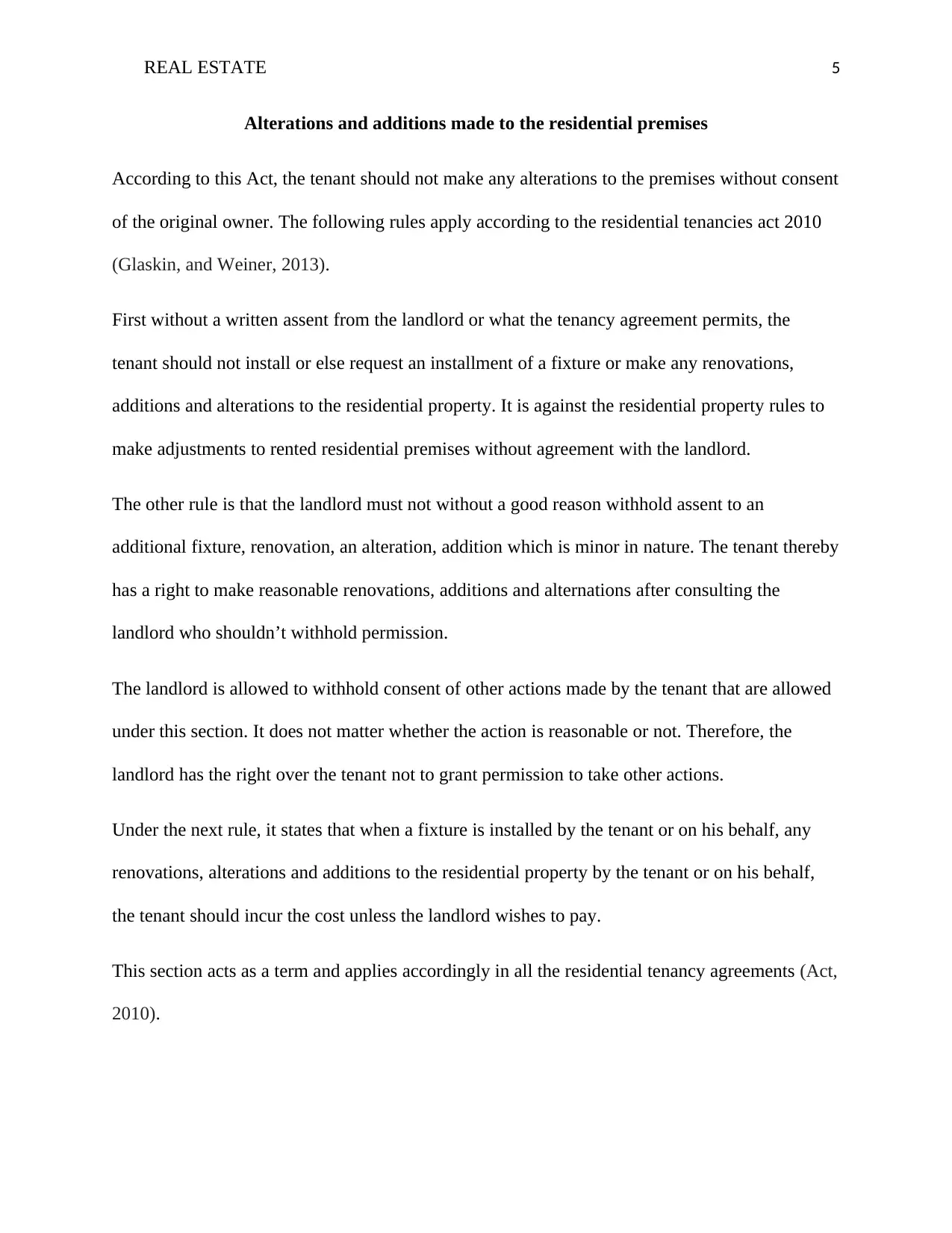
REAL ESTATE 5
Alterations and additions made to the residential premises
According to this Act, the tenant should not make any alterations to the premises without consent
of the original owner. The following rules apply according to the residential tenancies act 2010
(Glaskin, and Weiner, 2013).
First without a written assent from the landlord or what the tenancy agreement permits, the
tenant should not install or else request an installment of a fixture or make any renovations,
additions and alterations to the residential property. It is against the residential property rules to
make adjustments to rented residential premises without agreement with the landlord.
The other rule is that the landlord must not without a good reason withhold assent to an
additional fixture, renovation, an alteration, addition which is minor in nature. The tenant thereby
has a right to make reasonable renovations, additions and alternations after consulting the
landlord who shouldn’t withhold permission.
The landlord is allowed to withhold consent of other actions made by the tenant that are allowed
under this section. It does not matter whether the action is reasonable or not. Therefore, the
landlord has the right over the tenant not to grant permission to take other actions.
Under the next rule, it states that when a fixture is installed by the tenant or on his behalf, any
renovations, alterations and additions to the residential property by the tenant or on his behalf,
the tenant should incur the cost unless the landlord wishes to pay.
This section acts as a term and applies accordingly in all the residential tenancy agreements (Act,
2010).
Alterations and additions made to the residential premises
According to this Act, the tenant should not make any alterations to the premises without consent
of the original owner. The following rules apply according to the residential tenancies act 2010
(Glaskin, and Weiner, 2013).
First without a written assent from the landlord or what the tenancy agreement permits, the
tenant should not install or else request an installment of a fixture or make any renovations,
additions and alterations to the residential property. It is against the residential property rules to
make adjustments to rented residential premises without agreement with the landlord.
The other rule is that the landlord must not without a good reason withhold assent to an
additional fixture, renovation, an alteration, addition which is minor in nature. The tenant thereby
has a right to make reasonable renovations, additions and alternations after consulting the
landlord who shouldn’t withhold permission.
The landlord is allowed to withhold consent of other actions made by the tenant that are allowed
under this section. It does not matter whether the action is reasonable or not. Therefore, the
landlord has the right over the tenant not to grant permission to take other actions.
Under the next rule, it states that when a fixture is installed by the tenant or on his behalf, any
renovations, alterations and additions to the residential property by the tenant or on his behalf,
the tenant should incur the cost unless the landlord wishes to pay.
This section acts as a term and applies accordingly in all the residential tenancy agreements (Act,
2010).
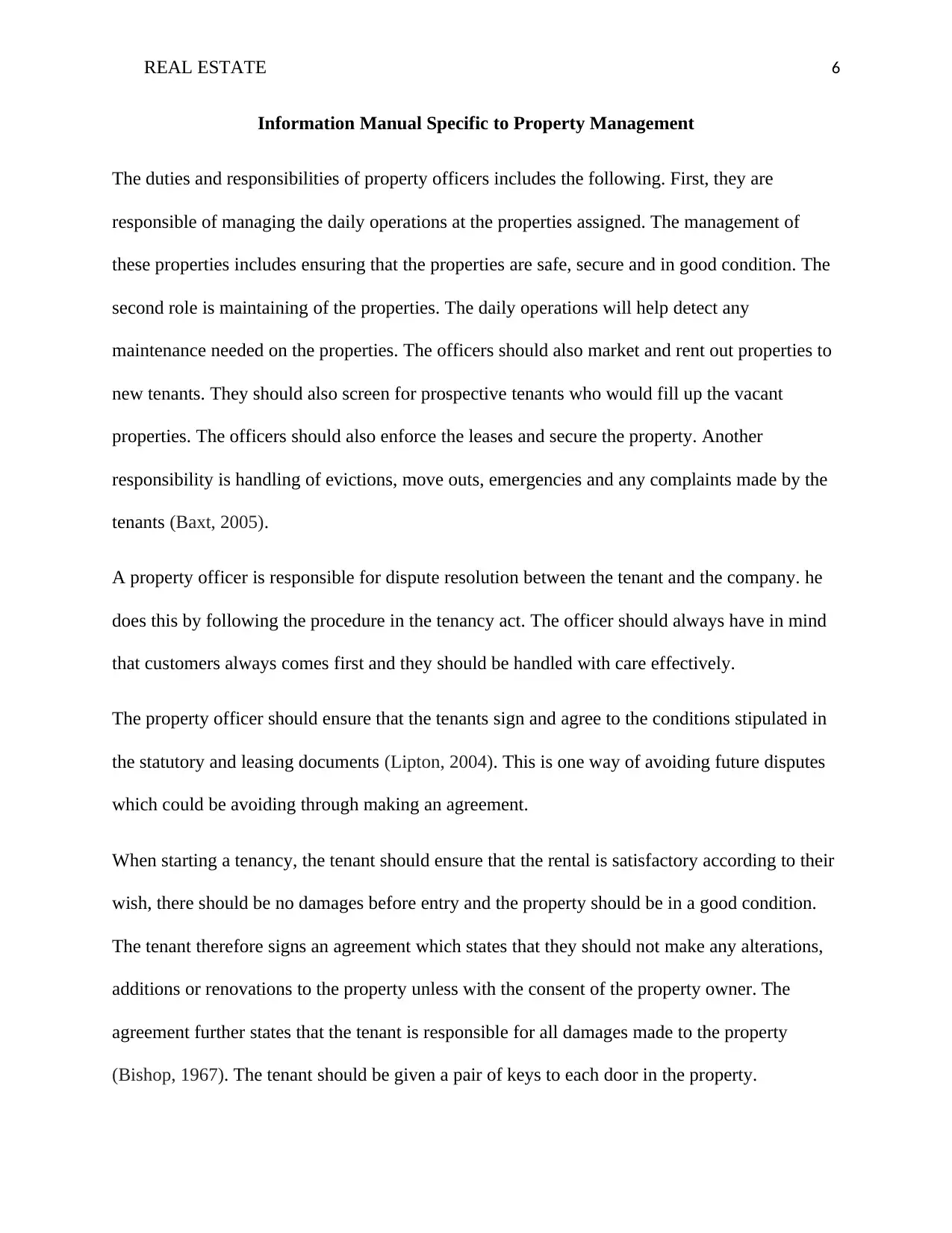
REAL ESTATE 6
Information Manual Specific to Property Management
The duties and responsibilities of property officers includes the following. First, they are
responsible of managing the daily operations at the properties assigned. The management of
these properties includes ensuring that the properties are safe, secure and in good condition. The
second role is maintaining of the properties. The daily operations will help detect any
maintenance needed on the properties. The officers should also market and rent out properties to
new tenants. They should also screen for prospective tenants who would fill up the vacant
properties. The officers should also enforce the leases and secure the property. Another
responsibility is handling of evictions, move outs, emergencies and any complaints made by the
tenants (Baxt, 2005).
A property officer is responsible for dispute resolution between the tenant and the company. he
does this by following the procedure in the tenancy act. The officer should always have in mind
that customers always comes first and they should be handled with care effectively.
The property officer should ensure that the tenants sign and agree to the conditions stipulated in
the statutory and leasing documents (Lipton, 2004). This is one way of avoiding future disputes
which could be avoiding through making an agreement.
When starting a tenancy, the tenant should ensure that the rental is satisfactory according to their
wish, there should be no damages before entry and the property should be in a good condition.
The tenant therefore signs an agreement which states that they should not make any alterations,
additions or renovations to the property unless with the consent of the property owner. The
agreement further states that the tenant is responsible for all damages made to the property
(Bishop, 1967). The tenant should be given a pair of keys to each door in the property.
Information Manual Specific to Property Management
The duties and responsibilities of property officers includes the following. First, they are
responsible of managing the daily operations at the properties assigned. The management of
these properties includes ensuring that the properties are safe, secure and in good condition. The
second role is maintaining of the properties. The daily operations will help detect any
maintenance needed on the properties. The officers should also market and rent out properties to
new tenants. They should also screen for prospective tenants who would fill up the vacant
properties. The officers should also enforce the leases and secure the property. Another
responsibility is handling of evictions, move outs, emergencies and any complaints made by the
tenants (Baxt, 2005).
A property officer is responsible for dispute resolution between the tenant and the company. he
does this by following the procedure in the tenancy act. The officer should always have in mind
that customers always comes first and they should be handled with care effectively.
The property officer should ensure that the tenants sign and agree to the conditions stipulated in
the statutory and leasing documents (Lipton, 2004). This is one way of avoiding future disputes
which could be avoiding through making an agreement.
When starting a tenancy, the tenant should ensure that the rental is satisfactory according to their
wish, there should be no damages before entry and the property should be in a good condition.
The tenant therefore signs an agreement which states that they should not make any alterations,
additions or renovations to the property unless with the consent of the property owner. The
agreement further states that the tenant is responsible for all damages made to the property
(Bishop, 1967). The tenant should be given a pair of keys to each door in the property.
⊘ This is a preview!⊘
Do you want full access?
Subscribe today to unlock all pages.

Trusted by 1+ million students worldwide
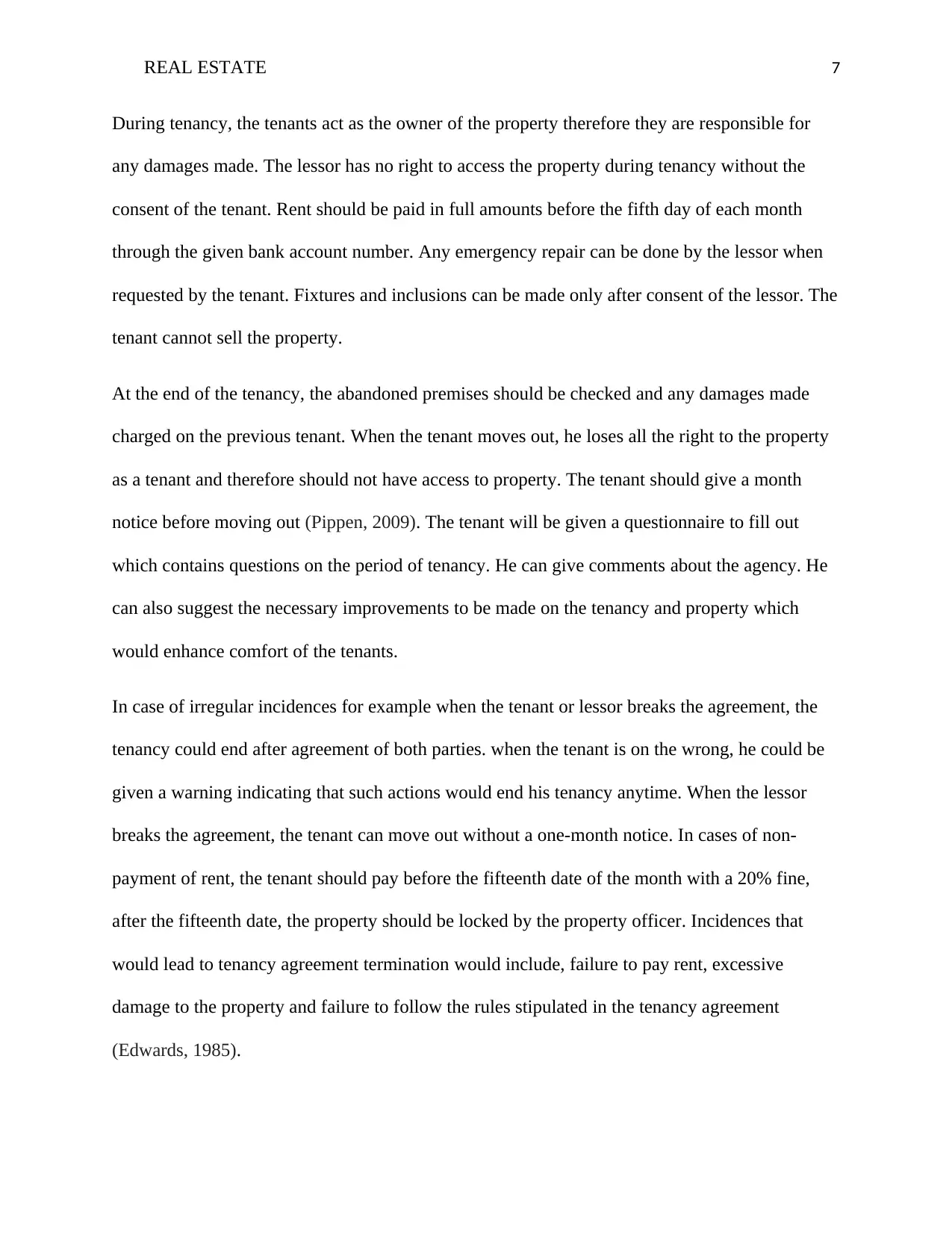
REAL ESTATE 7
During tenancy, the tenants act as the owner of the property therefore they are responsible for
any damages made. The lessor has no right to access the property during tenancy without the
consent of the tenant. Rent should be paid in full amounts before the fifth day of each month
through the given bank account number. Any emergency repair can be done by the lessor when
requested by the tenant. Fixtures and inclusions can be made only after consent of the lessor. The
tenant cannot sell the property.
At the end of the tenancy, the abandoned premises should be checked and any damages made
charged on the previous tenant. When the tenant moves out, he loses all the right to the property
as a tenant and therefore should not have access to property. The tenant should give a month
notice before moving out (Pippen, 2009). The tenant will be given a questionnaire to fill out
which contains questions on the period of tenancy. He can give comments about the agency. He
can also suggest the necessary improvements to be made on the tenancy and property which
would enhance comfort of the tenants.
In case of irregular incidences for example when the tenant or lessor breaks the agreement, the
tenancy could end after agreement of both parties. when the tenant is on the wrong, he could be
given a warning indicating that such actions would end his tenancy anytime. When the lessor
breaks the agreement, the tenant can move out without a one-month notice. In cases of non-
payment of rent, the tenant should pay before the fifteenth date of the month with a 20% fine,
after the fifteenth date, the property should be locked by the property officer. Incidences that
would lead to tenancy agreement termination would include, failure to pay rent, excessive
damage to the property and failure to follow the rules stipulated in the tenancy agreement
(Edwards, 1985).
During tenancy, the tenants act as the owner of the property therefore they are responsible for
any damages made. The lessor has no right to access the property during tenancy without the
consent of the tenant. Rent should be paid in full amounts before the fifth day of each month
through the given bank account number. Any emergency repair can be done by the lessor when
requested by the tenant. Fixtures and inclusions can be made only after consent of the lessor. The
tenant cannot sell the property.
At the end of the tenancy, the abandoned premises should be checked and any damages made
charged on the previous tenant. When the tenant moves out, he loses all the right to the property
as a tenant and therefore should not have access to property. The tenant should give a month
notice before moving out (Pippen, 2009). The tenant will be given a questionnaire to fill out
which contains questions on the period of tenancy. He can give comments about the agency. He
can also suggest the necessary improvements to be made on the tenancy and property which
would enhance comfort of the tenants.
In case of irregular incidences for example when the tenant or lessor breaks the agreement, the
tenancy could end after agreement of both parties. when the tenant is on the wrong, he could be
given a warning indicating that such actions would end his tenancy anytime. When the lessor
breaks the agreement, the tenant can move out without a one-month notice. In cases of non-
payment of rent, the tenant should pay before the fifteenth date of the month with a 20% fine,
after the fifteenth date, the property should be locked by the property officer. Incidences that
would lead to tenancy agreement termination would include, failure to pay rent, excessive
damage to the property and failure to follow the rules stipulated in the tenancy agreement
(Edwards, 1985).
Paraphrase This Document
Need a fresh take? Get an instant paraphrase of this document with our AI Paraphraser
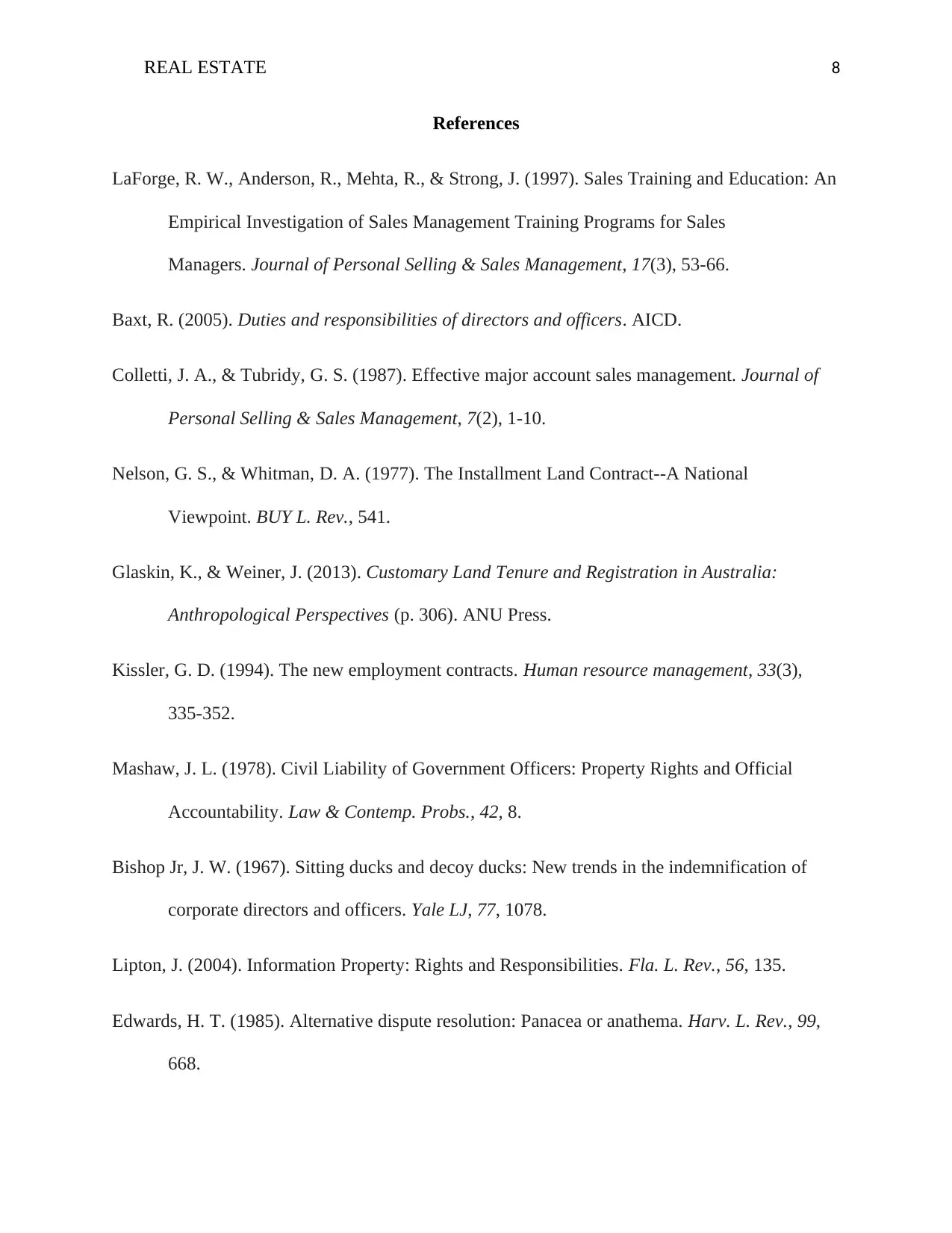
REAL ESTATE 8
References
LaForge, R. W., Anderson, R., Mehta, R., & Strong, J. (1997). Sales Training and Education: An
Empirical Investigation of Sales Management Training Programs for Sales
Managers. Journal of Personal Selling & Sales Management, 17(3), 53-66.
Baxt, R. (2005). Duties and responsibilities of directors and officers. AICD.
Colletti, J. A., & Tubridy, G. S. (1987). Effective major account sales management. Journal of
Personal Selling & Sales Management, 7(2), 1-10.
Nelson, G. S., & Whitman, D. A. (1977). The Installment Land Contract--A National
Viewpoint. BUY L. Rev., 541.
Glaskin, K., & Weiner, J. (2013). Customary Land Tenure and Registration in Australia:
Anthropological Perspectives (p. 306). ANU Press.
Kissler, G. D. (1994). The new employment contracts. Human resource management, 33(3),
335-352.
Mashaw, J. L. (1978). Civil Liability of Government Officers: Property Rights and Official
Accountability. Law & Contemp. Probs., 42, 8.
Bishop Jr, J. W. (1967). Sitting ducks and decoy ducks: New trends in the indemnification of
corporate directors and officers. Yale LJ, 77, 1078.
Lipton, J. (2004). Information Property: Rights and Responsibilities. Fla. L. Rev., 56, 135.
Edwards, H. T. (1985). Alternative dispute resolution: Panacea or anathema. Harv. L. Rev., 99,
668.
References
LaForge, R. W., Anderson, R., Mehta, R., & Strong, J. (1997). Sales Training and Education: An
Empirical Investigation of Sales Management Training Programs for Sales
Managers. Journal of Personal Selling & Sales Management, 17(3), 53-66.
Baxt, R. (2005). Duties and responsibilities of directors and officers. AICD.
Colletti, J. A., & Tubridy, G. S. (1987). Effective major account sales management. Journal of
Personal Selling & Sales Management, 7(2), 1-10.
Nelson, G. S., & Whitman, D. A. (1977). The Installment Land Contract--A National
Viewpoint. BUY L. Rev., 541.
Glaskin, K., & Weiner, J. (2013). Customary Land Tenure and Registration in Australia:
Anthropological Perspectives (p. 306). ANU Press.
Kissler, G. D. (1994). The new employment contracts. Human resource management, 33(3),
335-352.
Mashaw, J. L. (1978). Civil Liability of Government Officers: Property Rights and Official
Accountability. Law & Contemp. Probs., 42, 8.
Bishop Jr, J. W. (1967). Sitting ducks and decoy ducks: New trends in the indemnification of
corporate directors and officers. Yale LJ, 77, 1078.
Lipton, J. (2004). Information Property: Rights and Responsibilities. Fla. L. Rev., 56, 135.
Edwards, H. T. (1985). Alternative dispute resolution: Panacea or anathema. Harv. L. Rev., 99,
668.

REAL ESTATE 9
Pippen, D. (2009). Security of tenure: tenancy law reform [Paper in: Housing.]. Reform, (94), 20.
Act, R. T. (2010). No 42. State of NSW, < http://www. legislation. nsw. gov. au/maint
op/view/inforce/act, 42, 2010.
Pippen, D. (2009). Security of tenure: tenancy law reform [Paper in: Housing.]. Reform, (94), 20.
Act, R. T. (2010). No 42. State of NSW, < http://www. legislation. nsw. gov. au/maint
op/view/inforce/act, 42, 2010.
⊘ This is a preview!⊘
Do you want full access?
Subscribe today to unlock all pages.

Trusted by 1+ million students worldwide
1 out of 9
Related Documents
Your All-in-One AI-Powered Toolkit for Academic Success.
+13062052269
info@desklib.com
Available 24*7 on WhatsApp / Email
![[object Object]](/_next/static/media/star-bottom.7253800d.svg)
Unlock your academic potential
Copyright © 2020–2025 A2Z Services. All Rights Reserved. Developed and managed by ZUCOL.



